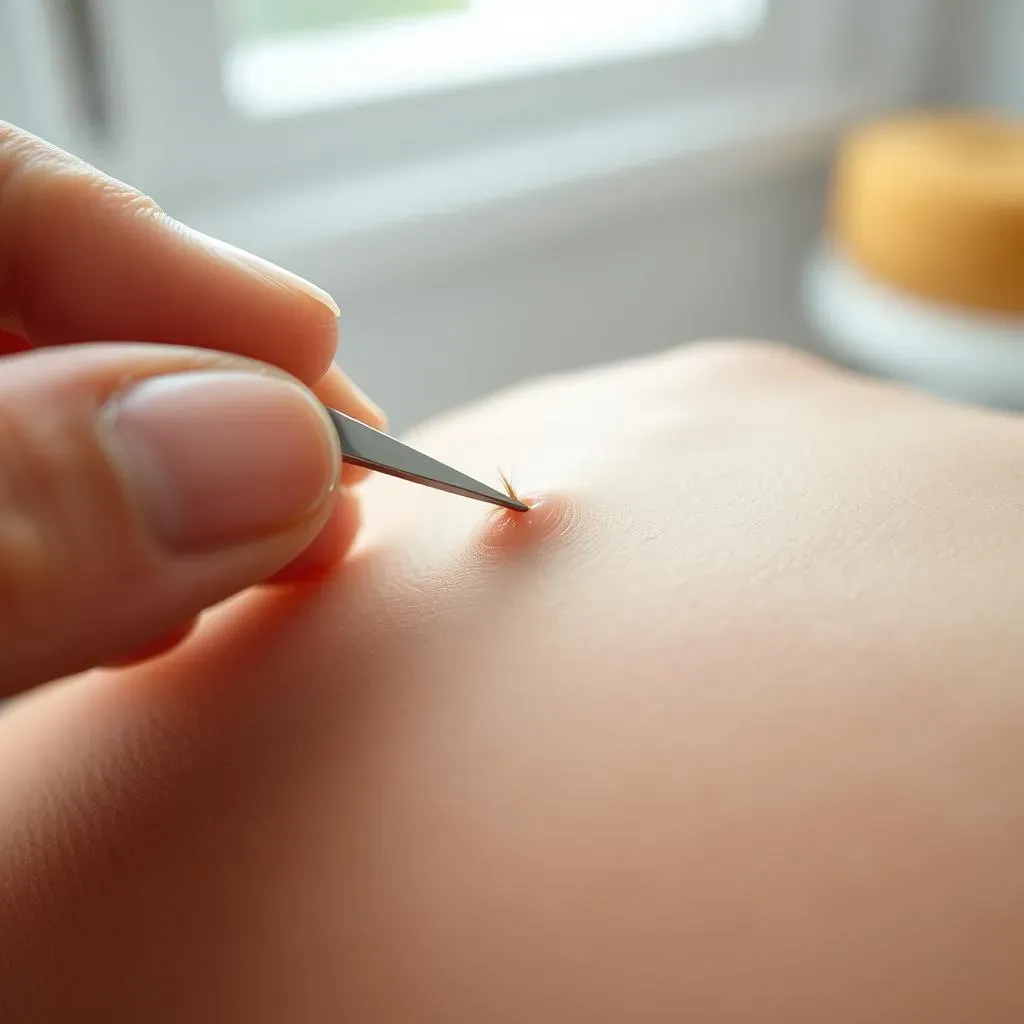Table of Contents
Are you tired of dealing with painful ingrown hairs and unsightly bumps on your skin? Ingrown hairs can be a frustrating and embarrassing issue, but there is hope for achieving smooth, healthy-looking skin. Satisfying ingrown hair removal is not only possible but also essential for maintaining skin health and confidence. In this article, we will delve into the world of ingrown hair removal, exploring the causes, symptoms, and most effective methods for satisfying ingrown hair removal. From home remedies to professional treatments, we will cover it all. Whether you're dealing with ingrown hairs on your face, legs, or other sensitive areas, this guide will provide you with the tips and tricks you need to say goodbye to ingrown hairs for good. So, let's get started on this journey to smooth, ingrown-hair-free skin with satisfying ingrown hair removal techniques.
What is Ingrown Hair and How Does it Occur

What is Ingrown Hair and How Does it Occur
Ingrown hairs occur when hair curves back into the skin instead of growing outwards, leading to inflammation, redness, and sometimes even infection. This can happen anywhere on the body where hair grows, but it's most common in areas like the beard, bikini line, and armpits. Ingrown hairs can be caused by a combination of factors, including genetics, tight clothing, poor shaving techniques, and curly or coarse hair.
When hair grows back into the skin, it can cause the skin to become irritated and inflamed, leading to symptoms such as redness, swelling, and pain. In severe cases, ingrown hairs can lead to the formation of cysts or abscesses, which may require medical attention. Understanding the causes and symptoms of ingrown hairs is crucial for effective satisfying ingrown hair removal.
Causes of Ingrown Hair | Symptoms | Prevention Tips |
|---|---|---|
Genetics, tight clothing, poor shaving techniques, curly or coarse hair | Redness, swelling, pain, inflammation, cysts or abscesses | Exfoliate regularly, use sharp razors, shave in the direction of hair growth, wear loose clothing |
- Avoid close shaving, as this can cause hair to become trapped in the skin
- Exfoliate the skin before shaving to remove dead skin cells and help hairs grow outwards
- Use a moisturizer after shaving to soothe the skin and reduce irritation
By understanding the causes and symptoms of ingrown hairs, individuals can take steps to prevent them from occurring in the first place. This not only reduces the risk of ingrown hairs but also promotes healthy, smooth skin.
Satisfying Ingrown Hair Removal Methods for Different Skin Types

Satisfying Ingrown Hair Removal Methods for Different Skin Types
Understanding Skin Types for Effective Ingrown Hair Removal
When it comes to satisfying ingrown hair removal, it's essential to consider the different skin types and their unique needs. Normal skin, oily skin, dry skin, and sensitive skin all require tailored approaches to minimize irritation and promote healthy hair growth. For example, individuals with oily skin may need to use products that control oil production, while those with dry skin may require moisturizing treatments to prevent dryness and irritation.
Similarly, sensitive skin demands gentle products and techniques to avoid exacerbating the condition. By understanding your skin type and adapting your ingrown hair removal method accordingly, you can reduce the risk of complications and achieve smoother, healthier-looking skin. Whether you're dealing with ingrown hairs on your face, arms, or legs, choosing the right technique for your skin type is crucial.
Skin Type | Characteristics | Recommended Ingrown Hair Removal Methods |
|---|---|---|
Normal Skin | Balanced oil production, neither too oily nor too dry | Exfoliation, shaving with a sharp razor, using a gentle moisturizer |
Oily Skin | Excessive oil production, prone to acne | Salicylic acid treatments, oil-controlling products, avoiding heavy moisturizers |
Dry Skin | Lack of moisture, prone to irritation | Moisturizing treatments, gentle exfoliation, avoiding harsh products |
Sensitive Skin | Easily irritated, may react to certain products | Gentle exfoliation, fragrance-free products, avoiding harsh chemicals |
- For normal skin, exfoliate 1-2 times a week and shave in the direction of hair growth
- For oily skin, use salicylic acid to control oil and prevent clogged pores
- For dry skin, apply a rich moisturizer after shaving to soothe and hydrate
- For sensitive skin, opt for fragrance-free products and gentle exfoliation techniques
Popular Ingrown Hair Removal Methods
There are several satisfying ingrown hair removal methods available, each with its own set of benefits and drawbacks. Depilatory creams, for instance, dissolve hair at the surface of the skin, making it easy to wipe away. However, they can be irritating to sensitive skin and may not be as effective for coarse or curly hair.
Waxing and sugaring are popular methods for removing ingrown hairs, as they pull hair out from the root, reducing the risk of regrowth. However, these methods can be painful and may cause redness and bumps, especially for those with sensitive skin. Threading is another option, which is quick and relatively painless but may not be suitable for all skin types.
Method | Benefits | Drawbacks |
|---|---|---|
Depilatory Creams | Easy to use, relatively painless | Irritation to sensitive skin, less effective for coarse hair |
Waxing/Sugaring | Reduces regrowth, suitable for most skin types | Painful, may cause redness and bumps |
Threading | Quick, relatively painless | May not be suitable for all skin types, requires skill |
- Consider your skin type and hair texture when choosing an ingrown hair removal method
- Depilatory creams are best for fine to medium hair, while waxing/sugaring is better for coarse hair
- Threading is ideal for shaping eyebrows and other small areas
Home Remedies for Ingrown Hair Removal: Do They Really Work?

Home Remedies for Ingrown Hair Removal: Do They Really Work?
Natural Remedies to the Rescue
When it comes to satisfying ingrown hair removal, many people turn to home remedies as a safer and more cost-effective alternative to professional treatments. One of the most popular home remedies is tea tree oil, which has natural antiseptic and anti-inflammatory properties. Applying a few drops of tea tree oil to the affected area can help reduce inflammation and prevent infection. Another effective remedy is aloe vera gel, which soothes the skin and promotes healing.
Exfoliation is also a crucial step in preventing and removing ingrown hairs. Using a sugar or salt scrub once or twice a week can help remove dead skin cells and allow hairs to grow outwards. For those with curly or coarse hair, using a warm compress can help loosen the hair follicle and make it easier to remove. Additionally, applying a mixture of baking soda and water to the affected area can help neutralize the pH and reduce inflammation.
Remedy | Benefits | Precautions |
|---|---|---|
Tea Tree Oil | Reduces inflammation, prevents infection | Dilute with carrier oil, patch test before use |
Aloe Vera Gel | Soothes skin, promotes healing | None, suitable for all skin types |
Sugar/Salt Scrub | Exfoliates skin, prevents ingrown hairs | Avoid over-exfoliating, 1-2 times a week |
Warm Compress | Loosens hair follicle, aids removal | Avoid using hot water, which can irritate skin |
Baking Soda and Water | Neutralizes pH, reduces inflammation | Avoid using baking soda on broken skin |
- Always patch test any new remedy to ensure you don't have any sensitivity or allergic reactions
- Combine remedies for enhanced effectiveness, such as using tea tree oil after exfoliating
- Be patient, as home remedies may take longer to show results compared to professional treatments
Evaluating the Effectiveness of Home Remedies
While home remedies can be effective for mild cases of ingrown hairs, they may not be suitable for more severe cases or for individuals with sensitive skin. It's essential to evaluate the effectiveness of each remedy and adjust as needed. For example, if you find that tea tree oil is causing irritation, you may want to switch to aloe vera gel instead. Similarly, if exfoliation is not providing the desired results, you may need to consider professional treatments.
It's also important to note that home remedies are not a substitute for good hygiene and skincare practices. Keeping the skin clean, using gentle products, and avoiding tight clothing can go a long way in preventing ingrown hairs. By combining home remedies with these best practices, you can achieve satisfying ingrown hair removal and maintain healthy, smooth skin.
Remedy | Effectiveness | Possible Side Effects |
|---|---|---|
Tea Tree Oil | Highly effective for reducing inflammation | May cause irritation or allergic reactions in some individuals |
Aloe Vera Gel | Effective for soothing and healing | Generally considered safe, with rare cases of allergic reactions |
Exfoliation | Effective for preventing ingrown hairs | May cause irritation or dryness if overdone |
- Monitor your skin's response to each remedy and adjust as needed
- Combine remedies for enhanced effectiveness, but avoid overusing
- Consult a dermatologist if home remedies are not providing the desired results
Professional Ingrown Hair Removal: Is it Worth the Investment?

Professional Ingrown Hair Removal: Is it Worth the Investment?
Laser Hair Removal: A Permanent Solution
For those tired of dealing with ingrown hairs and seeking a more permanent solution, laser hair removal is an option worth considering. This professional treatment uses high-heat lasers to target and destroy hair follicles, reducing the risk of ingrown hairs. Laser hair removal is particularly effective for individuals with curly or coarse hair, as it can significantly reduce regrowth and prevent future ingrown hairs.
However, laser hair removal can be expensive, and multiple sessions are often required for optimal results. Additionally, it may not be suitable for all skin types, and there is a risk of side effects such as burns or discoloration. Despite these drawbacks, many people find laser hair removal to be a worthwhile investment for the long-term benefits it provides.
Benefits | Risks | Cost |
|---|---|---|
Permanent reduction of ingrown hairs, suitable for curly/coarse hair | Burns, discoloration, may require multiple sessions | Varies depending on location and number of sessions, approximately $200-$500 per session |
- Consult a qualified dermatologist or practitioner to discuss suitability and risks
- Prepare for multiple sessions, as results may vary
- Consider the long-term cost savings of reduced ingrown hair maintenance
Electrolysis: A Chemical-Free Alternative
Electrolysis is another professional ingrown hair removal method that uses a small electrical charge to destroy hair follicles. This treatment is chemical-free and can be more gentle on the skin compared to other methods. Electrolysis is suitable for most skin types and can be used on sensitive areas, making it a popular choice for those seeking a more natural approach.
However, electrolysis can be a time-consuming process, as each hair follicle is treated individually. This can make it more expensive than other methods, especially for larger areas. Additionally, electrolysis may require multiple sessions to achieve desired results.
Benefits | Risks | Cost |
|---|---|---|
Chemical-free, suitable for sensitive skin, permanent results | Time-consuming, may require multiple sessions, can be expensive | $50-$200 per session, depending on the practitioner and location |
- Find an experienced practitioner to minimize discomfort and ensure effective treatment
- Be patient, as multiple sessions may be needed for optimal results
- Consider the long-term benefits and cost savings of permanent hair removal
Professional Ingrown Hair Removal at hairawaybylaser.com
For those seeking professional ingrown hair removal, hairawaybylaser.com offers a range of treatments, including laser hair removal and electrolysis. Their team of qualified practitioners provides personalized consultations to determine the best course of treatment for each individual's skin type and hair texture.
Professional ingrown hair removal can be a significant investment, but the results are often well worth the cost. By choosing a reputable clinic like hairawaybylaser.com, individuals can achieve smooth, healthy-looking skin and say goodbye to the frustration of ingrown hairs for good.
Conclusion: Achieving Smooth Skin with Satisfying Ingrown Hair Removal
In conclusion, satisfying ingrown hair removal is within reach, regardless of your skin type or the severity of the issue. By understanding the causes of ingrown hairs and exploring the various removal methods, you can take the first steps towards smoother, healthier skin. Whether you opt for home remedies or professional treatments, remember that patience and consistency are key. Don't let ingrown hairs hold you back any longer – start your journey to ingrown-hair-free skin today with these satisfying ingrown hair removal techniques. Visit hairawaybylaser.com for more information on professional hair removal solutions.
